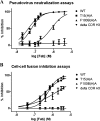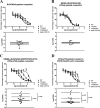Ablation of the complementarity-determining region H3 apex of the anti-HIV-1 broadly neutralizing antibody 2F5 abrogates neutralizing capacity without affecting core epitope binding
- PMID: 20147404
- PMCID: PMC2863773
- DOI: 10.1128/JVI.02357-09
Ablation of the complementarity-determining region H3 apex of the anti-HIV-1 broadly neutralizing antibody 2F5 abrogates neutralizing capacity without affecting core epitope binding
Abstract
The identification and characterization of broadly neutralizing antibodies (bnAbs) against HIV-1 has formed a major research focus, with the ultimate goal to help in the design of an effective AIDS vaccine. One of these bnAbs, 2F5, has been extensively characterized, and residues at the apex of its unusually long complementarity-determining region (CDR) H3 loop have been shown to be crucial for neutralization. Structural studies, however, have revealed that the (100)TLFGVPI(100F) apex residues of the CDR H3 loop do not interact directly with residues of its core gp41 epitope. In an attempt to gain better insight into the functional role of this element, we have recombinantly expressed native 2F5 Fab and two mutants in which either the apical Phe100B(H) residue was changed to an alanine or the CDR H3 residues (100)TLFGVPI(100F) were replaced by a Ser-Gly dipeptide linker. Isothermal titration calorimetry (ITC) and competitive-binding enzyme-linked immunosorbent assays (ELISAs) rendered strikingly similar affinity constants (K(d) [dissociation constant] of approximately 20 nM) for linear peptide epitope binding by 2F5 Fabs, independent of the presence or absence of the apex residues. Ablation of the CDR H3 apex residues, however, abolished the cell-cell fusion inhibition and pseudovirus neutralization capacities of 2F5 Fab. We report competitive ELISA data that suggest a role of 2F5 CDR H3 apex residues in mediating weak hydrophobic interactions with residues located at the C terminus of the gp41 membrane proximal external region and/or membrane components in the context of core epitope binding. The present data therefore imply an extended 2F5 paratope that includes weak secondary interactions that are crucial for neutralization of Env-mediated fusion.
Figures






References
-
- Abramoff, M. D., P. J. Magelhaes, and S. J. Ram. 2004. Image processing with ImageJ. Biophotonics Int. 11:36-42.
-
- Alam, S. M., M. McAdams, D. Boren, M. Rak, R. M. Scearce, F. Gao, Z. T. Camacho, D. Gewirth, G. Kelsoe, P. Chen, and B. F. Haynes. 2007. The role of antibody polyspecificity and lipid reactivity in binding of broadly neutralizing anti-HIV-1 envelope human monoclonal antibodies 2F5 and 4E10 to glycoprotein 41 membrane proximal envelope epitopes. J. Immunol. 178:4424-4435. - PMC - PubMed
-
- Arnold, G. F., P. K. Velasco, A. K. Holmes, T. Wrin, S. C. Geisler, P. Phung, Y. Tian, D. A. Resnick, X. Ma, T. M. Mariano, C. J. Petropoulos, J. W. Taylor, H. Katinger, and E. Arnold. 2009. Broad neutralization of human immunodeficiency virus type 1 (HIV-1) elicited from human rhinoviruses that display the HIV-1 gp41 ELDKWA epitope. J. Virol. 83:5087-5100. - PMC - PubMed
Publication types
MeSH terms
Substances
Grants and funding
LinkOut - more resources
Full Text Sources
Other Literature Sources
Miscellaneous

